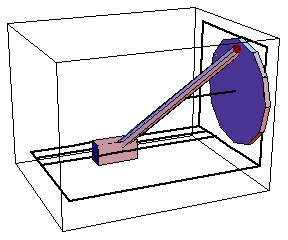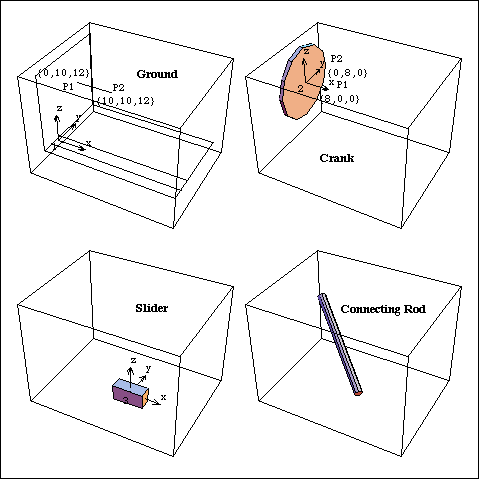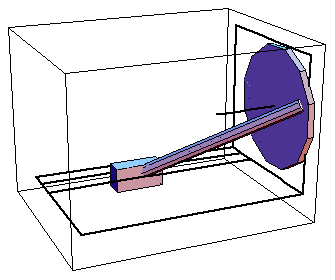3.2.1 Example Mechanism To demonstrate the use of Modeler3D output functions, a 3D model is developed that can be measured. The model is a spatial slider-crank mechanism consisting of two moving bodies, the crank and the slider. A real slider-crank mechanism would have a fourth body, the connecting rod between the crank and the slider.
The motion of the slider-crank mechanism is driven by the rotation of the crank, which forces the slider to reciprocate in a straight track that is parallel to the axis of the crank. The crank is attached to the slider via a connecting rod that is modeled by a distance constraint. This loads the Modeler3D package. Here is a graphic of the complete 3D slider-crank model.

BodiesThree body objects are defined for the slider-crank mechanism model. Note that the zeroth point is used in this model to avoid repeatedly defining a point at coordinates {0, 0, 0}. The ground (body 1) has four points defined in its body object.
P1 and P2 are two points to define the rotational axis of the crank.
P3 and P4 are two points that are used in conjunction with the origin of the ground body to define the translation axis and reference direction of the slider. P4 is also used with the local origin to define a reference direction for the crank's rotation.The crank (body 2) has two points defined in its body object.
P1 is a point that is used with the crank's local origin to define its rotational axis.
P2 is the attachment point of the connecting rod, and also a reference for the crank's rotation.The slider (body 3) has two points defined in its body object.
P0 is the attachment point of the connecting rod on the slider.
P1 is used with the slider's local origin to define its translation axis.
P2 is used with the slider's local origin to define a reference direction for the translational joint.Here are all the bodies in the slider-crank model.

Here are names for each of the body numbers in the model. Here are body objects for each body. This incorporates the body properties into the current model. ConstraintsFour constraints are used to model the slider-crank mechanism. A Revolute5 constraint forces the axis of the crank to be coincident with its pivot axis on the ground. This leaves only one degree of freedom for the crank, rotation about its axis.A ProjectedAngle1 constraint specifies the angular relationship between a line on the ground body and a line on the crank. This driving constraint is used to rotate the crank.A RelativeDistance1 constraint between the crank and the slider replaces the pseudo-connecting rod, which is 30 units long.A Translate5 constraint between the slider and the ground leaves only one degree of freedom for the slider; horizontal translation along a track on the ground body. This constraint references two Modeler3D Axis objects that are constrained to be parallel and coincident, and the reference directions of the two axes are constrained to be coplanar.Here are the constraints for the slider-crank model. This incorporates the constraints into the current model. RuntimeNow run the model at T = 0.05.
Out[14]= |  |
Here is the slider-crank model at T = 0.05.

|